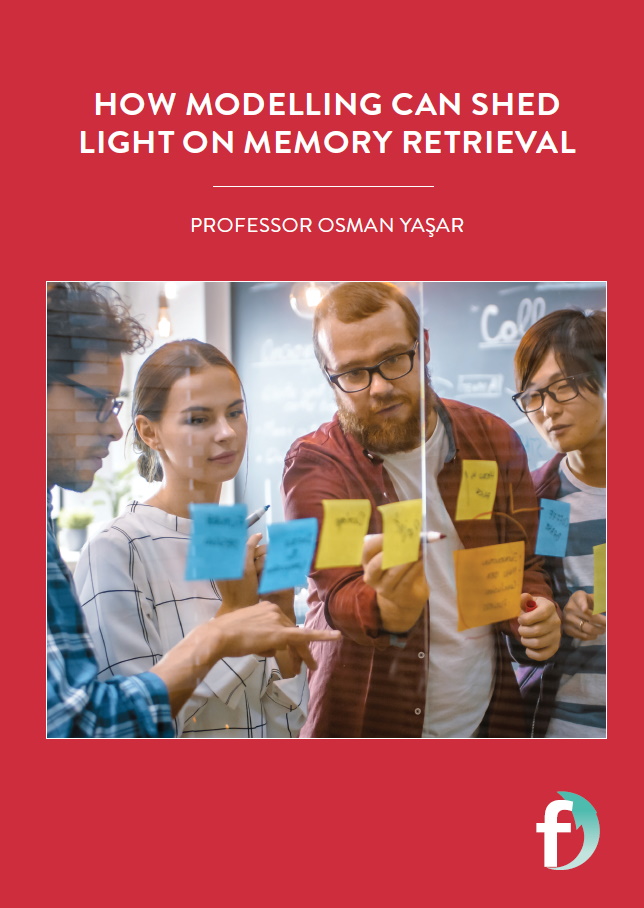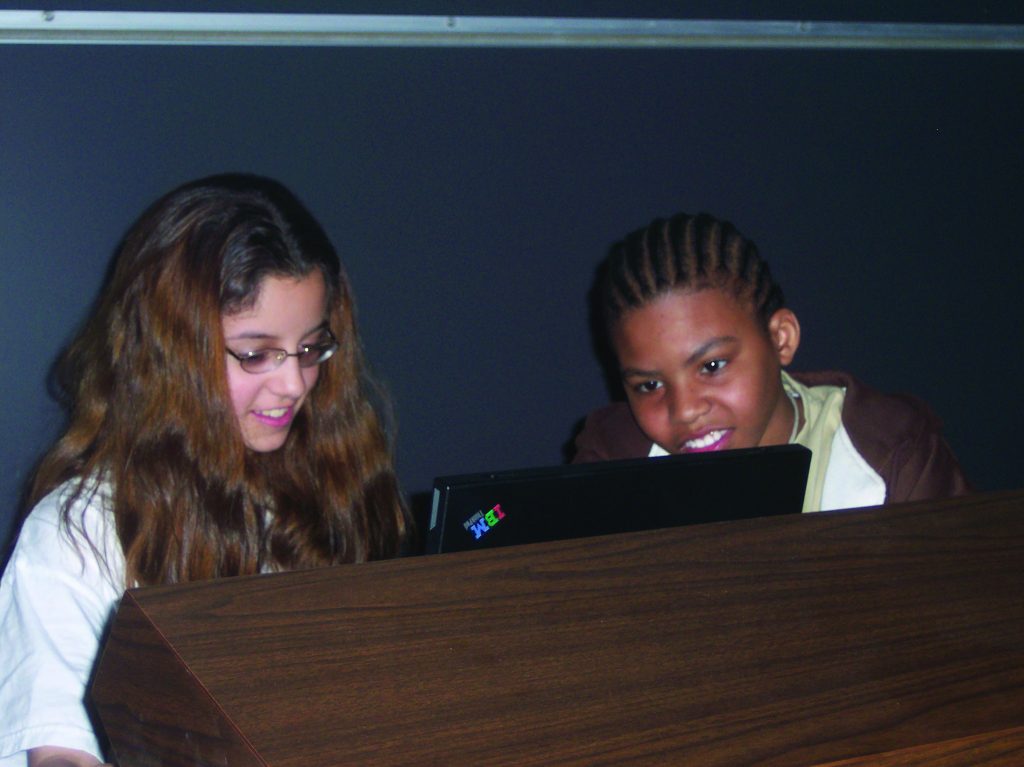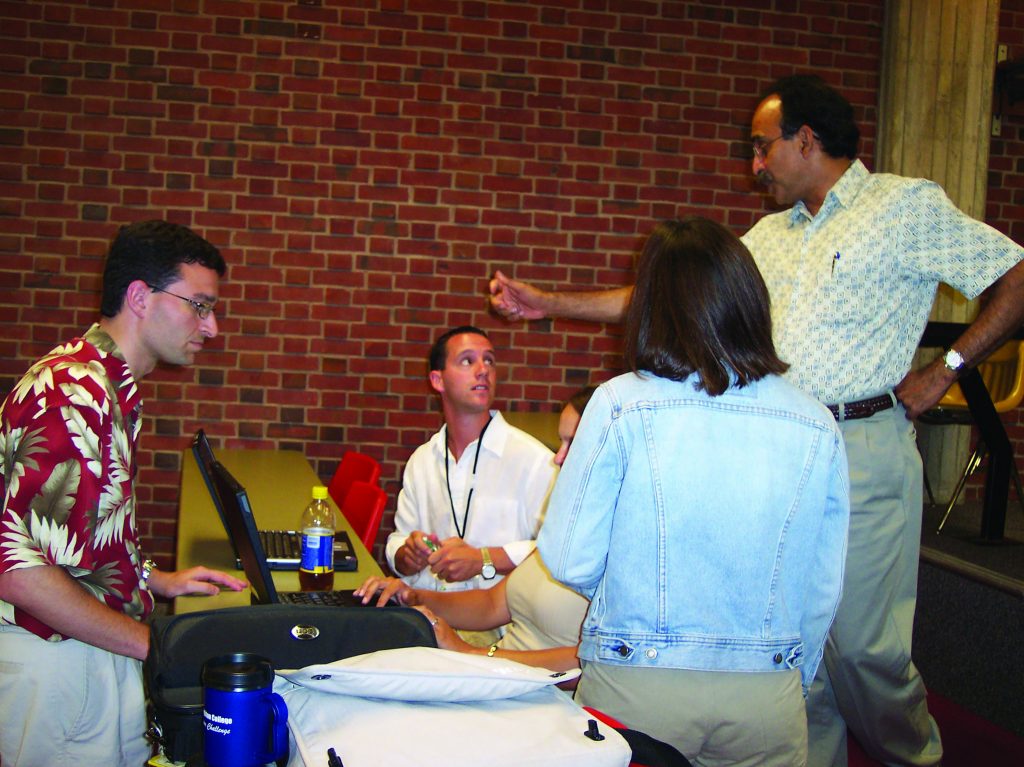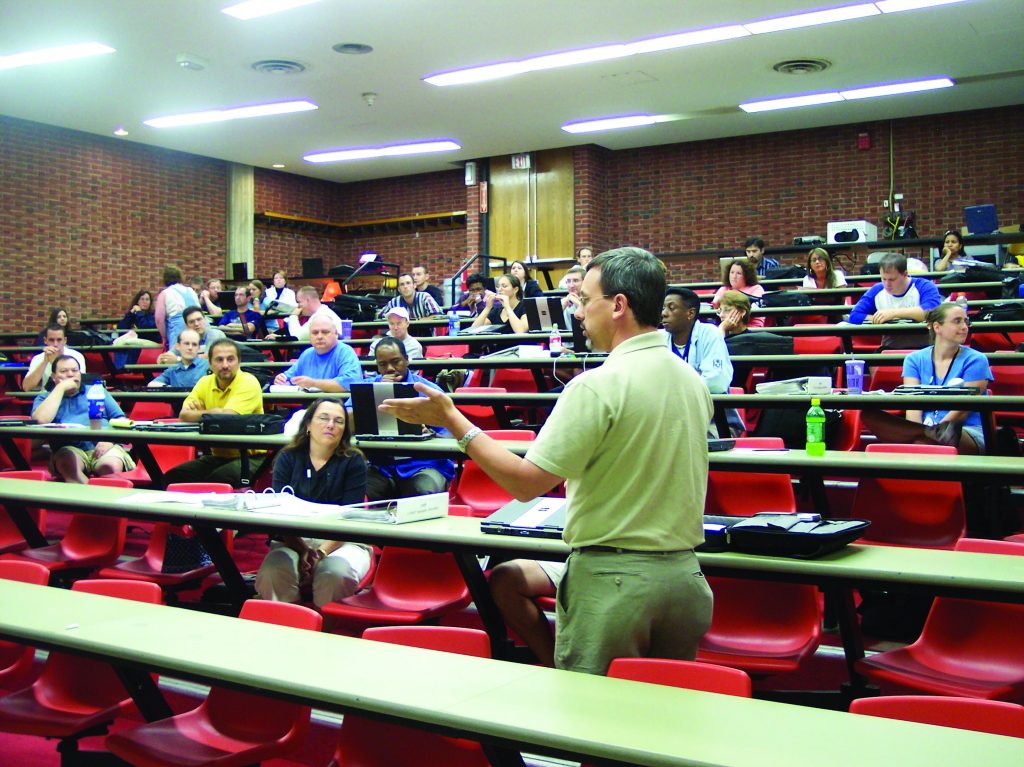How modelling can shed light on memory retrieval
Computational thinking describes the way we break down problems or draw conclusions from observations. We use it in everyday life, but Professor Osman Yaşar, based at the Computational Math, Science, and Technology Institute at the State University of New York in the US, believes we can learn to use it more effectively. He trains teachers to teach students to think in ways that improve their memory and problem-solving abilities, setting them up for shining careers in STEM
GLOSSARY
BLOCKED PRACTICE – a way of learning involving repeatedly practising a skill or process, without the interruption of other activities
COMPUTATIONAL THINKING – a way of thinking that uses deductive thinking and inductive thinking to tackle complex problems, understand them and generate solutions
DEDUCTIVE THINKING – taking a general conceptual idea and applying it to various circumstances, observations or possibilities to examine its validity. Also known as a top-down approach, decomposition or analysis
GENERATIVE RETRIEVAL PRACTICE – a form of memory retrieval and learning involving effort and prompts to answer a question, solve a problem, or draw conclusions without being presented with possible answers or solutions
INDUCTIVE THINKING – taking data and/or observations and using them altogether to come up with general ideas, concepts or theories. Also known as a bottom-up approach, abstraction or synthesis
INTERLEAVED RETRIEVAL PRACTICE – a form of memory retrieval and learning involving meshing topics and solutions together (as opposed to blocked practice)
SCIENTIFIC THINKING – a way of thinking that a scientist employs during inquiry. It includes both the content of sciences and a set of cognitive processes that permeate the field of sciences. These processes include problem solving; the formation and testing of hypotheses, concepts and models; conceptual change; and a set of reasoning skills such as deductive, inductive, abductive, causal and analogical thinking
Professor Osman Yaşar has been working with schools for over two decades, initially as a pioneer of bringing computer science into the classroom. Now, he shares important lessons from computational and cognitive sciences to help teachers improve lesson and curriculum structure. Osman’s aim is to enhance students’ memory capacity and set them up with effective ways of thinking for life.
COMPUTATION IN THE CLASSROOM
Osman has been involved in the computational sciences since the mid 1980s, when advances in computer modelling made it an effective alternative research strategy to real-world experiments. “Computational modelling and simulation technology (CMST) helped surpass issues of experimental studies, which were held back by their size, the risks involved and prohibitive costs,” says Osman. “However, this transition required professionals proficient in computational methods and tools, as well as skills in mathematics and science.” Given that computational science was not taught below graduate level at that time, procuring new talent was a real issue.
“In response to this lack of a qualified workforce, I decided to form the world’s first undergraduate degree programme in computational science,” says Osman. “Several years into this programme, I realised that the pool of STEM-orientated students was shrinking long before they reached universities – so I took the challenge to the school level.” This involved training teachers in how to use CMST tools and why they were useful. This naturally gathered pace as computers became household items, with computational thinking now often recommended in curriculums.
Funding from the National Science Foundation gave a welcome boost to Osman’s training efforts. “Participation by teachers was voluntary, but funds and other incentives were used to encourage teachers to attend training,” says Osman. “Recruitment of students for project activities was left to teachers, though they were first educated about the importance of diversity.” Over the years since, Osman’s work has expanded to include younger and younger students, with even elementary students now able to participate using easy-to use computer simulations.
COMPUTATIONAL THINKING
Osman’s work does not just purely focus on paving the way for the next generation of computer scientists. He also draws parallels between computation and cognition, lately through the ITEST (Innovative Technology Experiences and Teachers) programme. “Our teacher training work initially involved the use of computational modelling and simulation tools, but as we discovered the link between computation and cognition, we started teaching teachers and students memory retrieval strategies to help retain knowledge and support meaningful and in-depth learning in STEM,” he says.
This way of processing information is known as computational thinking (CT). Osman states that all computing devices – which includes our own brains – process information in similar ways. “Our brains are efficient computing devices, quantifying the information we perceive around us,” he says. “By using these computational processes consistently, frequently and methodically, we can become smarter, more knowledgeable and better able to retain information.”
Reference
https://doi.org/10.33424/FUTURUM221
BLOCKED PRACTICE – a way of learning involving repeatedly practising a skill or process, without the interruption of other activities
COMPUTATIONAL THINKING – a way of thinking that uses deductive thinking and inductive thinking to tackle complex problems, understand them and generate solutions
DEDUCTIVE THINKING – taking a general conceptual idea and applying it to various circumstances, observations or possibilities to examine its validity. Also known as a top-down approach, decomposition or analysis
GENERATIVE RETRIEVAL PRACTICE – a form of memory retrieval and learning involving effort and prompts to answer a question, solve a problem, or draw conclusions without being presented with possible answers or solutions
INDUCTIVE THINKING – taking data and/or observations and using them altogether to come up with general ideas, concepts or theories. Also known as a bottom-up approach, abstraction or synthesis
INTERLEAVED RETRIEVAL PRACTICE – a form of memory retrieval and learning involving meshing topics and solutions together (as opposed to blocked practice)
SCIENTIFIC THINKING – a way of thinking that a scientist employs during inquiry. It includes both the content of sciences and a set of cognitive processes that permeate the field of sciences. These processes include problem solving; the formation and testing of hypotheses, concepts and models; conceptual change; and a set of reasoning skills such as deductive, inductive, abductive, causal and analogical thinking
Professor Osman Yaşar has been working with schools for over two decades, initially as a pioneer of bringing computer science into the classroom. Now, he shares important lessons from computational and cognitive sciences to help teachers improve lesson and curriculum structure. Osman’s aim is to enhance students’ memory capacity and set them up with effective ways of thinking for life.
COMPUTATION IN THE CLASSROOM
Osman has been involved in the computational sciences since the mid 1980s, when advances in computer modelling made it an effective alternative research strategy to real-world experiments. “Computational modelling and simulation technology (CMST) helped surpass issues of experimental studies, which were held back by their size, the risks involved and prohibitive costs,” says Osman. “However, this transition required professionals proficient in computational methods and tools, as well as skills in mathematics and science.” Given that computational science was not taught below graduate level at that time, procuring new talent was a real issue.
“In response to this lack of a qualified workforce, I decided to form the world’s first undergraduate degree programme in computational science,” says Osman. “Several years into this programme, I realised that the pool of STEM-orientated students was shrinking long before they reached universities – so I took the challenge to the school level.” This involved training teachers in how to use CMST tools and why they were useful. This naturally gathered pace as computers became household items, with computational thinking now often recommended in curriculums.
Funding from the National Science Foundation gave a welcome boost to Osman’s training efforts. “Participation by teachers was voluntary, but funds and other incentives were used to encourage teachers to attend training,” says Osman. “Recruitment of students for project activities was left to teachers, though they were first educated about the importance of diversity.” Over the years since, Osman’s work has expanded to include younger and younger students, with even elementary students now able to participate using easy-to use computer simulations.
COMPUTATIONAL THINKING
Osman’s work does not just purely focus on paving the way for the next generation of computer scientists. He also draws parallels between computation and cognition, lately through the ITEST (Innovative Technology Experiences and Teachers) programme. “Our teacher training work initially involved the use of computational modelling and simulation tools, but as we discovered the link between computation and cognition, we started teaching teachers and students memory retrieval strategies to help retain knowledge and support meaningful and in-depth learning in STEM,” he says.
This way of processing information is known as computational thinking (CT). Osman states that all computing devices – which includes our own brains – process information in similar ways. “Our brains are efficient computing devices, quantifying the information we perceive around us,” he says. “By using these computational processes consistently, frequently and methodically, we can become smarter, more knowledgeable and better able to retain information.”
CT can be categorised further into two directions. Deductive thinking involves taking a broad concept and testing it using observations at a smaller scale. Inductive thinking covers the reverse process: making observations, collecting data, and using this to formulate a broad concept. ITEST’s latest venture is building mobile apps to teach computational thinking and memory retrieval strategies in a STEM context. Osman highlights scientists and engineers as two groups who often deliberately employ computational ways of thinking in their work, but emphasises that everyone thinks in these ways in their day-to-day lives to some degree.
He believes that employing these methods early on in education could bring benefits to students’ cognitive capacity. “We know that such capacity can be improved beyond what is inherited through experience and education,” he says.
IMPROVEMENTS AND ACCOLADES
Osman has the data to back up his claims. “Our decades-long experience and empirical data indicate that computational pedagogy and the use of CMST tools foster STEM learning and boost interest in CT and computer programming,” he says. He has partnered with secondary schools in the Greater Rochester area of New York, training over 1,200 teachers in total. Students taught by these teachers saw test scores improve by 15% to 40% in maths and science, and experienced big boosts to interest and enrolment in physics and computer science courses.
Osman’s team has also offered professional development to secondary school teachers to use memory retrieval practices in STEM courses. Resources they have supplied include simple quizzes spaced out throughout the year and computer simulations. “Studies found that students who learned STEM topics through retrieval practices consistently scored up to 30% better than those using standard practices,” says Osman. “Retrieval practices involve mixing topics and types of questions, and students are faced with choosing a strategy to solve a problem.”
The team has received a number of accolades that reflect the impact of their work. “Our peer-reviewed publications have received best-paper awards in conferences, and our main partner, Rochester City School District, received the National Superintendent of the Year Award in 2006,” says Osman. He has also testified before US Congress along with two teachers, advocating the effectiveness of his teaching methods. “We hope to scale up our work to a national level and expand its utilisation to include elementary teachers and students,” he says.
 PROFESSOR OSMAN YAŞAR
PROFESSOR OSMAN YAŞAR
Computational Math, Science, and Technology (CMST) Institute
State University of New York (SUNY)- Brockport
USA
FIELD OF RESEARCH – Computational Science, STEM Education
RESEARCH PROJECT – Training teachers to use computational thinking to improve learning and memory retrieval in the classroom, and inspire an interest in computational science
FUNDER – National Science Foundation
 PROFESSOR OSMAN YAŞAR
PROFESSOR OSMAN YAŞAR
Computational Math, Science, and Technology (CMST) Institute
State University of New York (SUNY)- Brockport
USA
FIELD OF RESEARCH – Computational Science, STEM Education
RESEARCH PROJECT – Training teachers to use computational thinking to improve learning and memory retrieval in the classroom, and inspire an interest in computational science
FUNDER – National Science Foundation
ABOUT MEMORY RETRIEVAL AND COMPUTATIONAL THINKING
Computational thinking is not just done by scientists. “For years, society believed that scientists had a special mindset to help them pursue scientific work,” says Osman. “Now, through laboratory observations and findings in neuroscience, we know that the cognitive processes that scientists use are no different from what everyone uses in their day-to-day lives. The difference comes from how they are used.” Osman believes that people can be taught to use computational thinking and scientific thinking skills more effectively, helping them perform better in school, work and the everyday.
The ITEST programme puts this idea into practice. “We should teach everyone how to think like a scientist,” says Osman. “Inductive and deductive thinking are the most important elements, but only when used in combination. Most of us tend to use one of them more than the other, which leads to problems.” Learning to use both ways of thinking frequently and cyclically can be taught but may require moving away from the standard ways of teaching.
OLD AND NEW TEACHING PRACTICES
‘Blocked practice’ refers to the way that subjects are traditionally taught in schools. This method teaches well-defined rules and methods linked to a particular topic for a block period of time, testing them, and then moving on to another topic. Osman says this is not an efficient way to learn. “Repeated practice of a method in a short period of time does build up skills and memory, but only for a short period of time,” he says. “These skills deteriorate once the topic is ended, such as right after a test.” To ensure the information learned enters long-term memory, a different approach is needed.
Osman is an advocate of interleaved retrieval practice as an alternative. “This practice takes place when the memory retrieval process is spaced-out, with topics overlapping with one another in time,” he says. This means that rather than teaching one topic after another, they are instead enmeshed over a longer period of time. This means that students will return to a topic after learning something else, rather than learning a whole topic at once. “This process involves some forgetting, but this can be a good thing,” says Osman. “When memory retrieval is more challenging, it ultimately forms a stronger and longer-lasting memory.”
A related and complementary technique is generative retrieval practice, which does not teach specific solutions to specific questions, but rather encourages students to decide what solution is appropriate. This draws on computational thinking. “We need to teach students to make a habit of using inductive and deductive thinking regularly, and in a cyclical fashion,” says Osman. “This will mean that when they are taught a concept, they will first break it down (deductive thinking), and then use its constituents to understand new or modified concepts (inductive thinking).”
OVERCOMING CHALLENGES
With less efficient teaching methods, students can struggle to find STEM subjects engaging, especially when they feel overwhelmed by large quantities of facts to remember. Osman is keen to dispel such negative perceptions. “Learning can be a joyful activity with the right strategy in place,” he says. “The challenge is that implementing a new strategy usually goes against the status quo.” STEM involves a lot of problem-solving, which is best approached through deductive and inductive thinking. Training teachers to use these learning strategies is, Osman believes, key to changing perceptions and helping students become more enthusiastic about STEM – but they cannot do it alone.
“To help teachers enact these changes, they need the support of their schools,” says Osman. “This applies to training, equipment, and the freedom to apply these new strategies.” Educational organisations can often help with this, and Osman has a database of lesson plans and curriculum modules that can kick-start this process. “The first thing that’s needed is the desire from the teacher to employ this new strategy,” he says.
“They can then become part of a community of like-minded people. From there, they need to obtain the support of their school administrators.” Osman has already helped many teachers meet these challenges, and hopes to do the same for many more.
Do you have a question for Osman?
Write it in the comments box below and Osman will get back to you. (Remember, researchers are very busy people, so you may have to wait a few days.)








